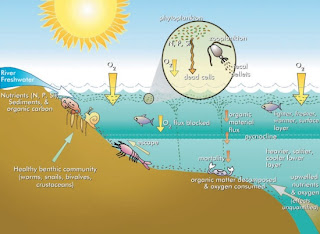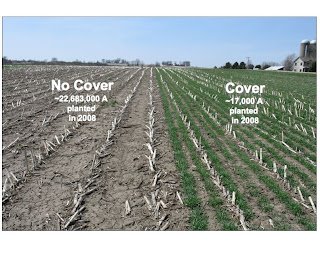COVER CROPS: Excellent Bang for FARMER’s Conservation Buck
On Sept 24th, the Gulf of Mexico Hypoxia Task Force took a farm tour of Iowa’s efforts to reduce nitrogen, phosphorus and sediment to the Gulf of Mexico. 3 busloads of EPA, NRCS, Army Corps, FSA, IDALS, ISU, etc representatives toured various nutrient reduction strategies within about a 100 mile radius of Des Moines.
This is a picture of why hypoxia occurs:
I presented about PFI’s work on cover crops and the benefits of this practice. The message was simple:
Reality of Iowa Agriculture
- Soil in Iowa is uncovered for at least 6 months/year
- Greatest loss of nutrients is outside the cropping season (Kaspar et al., 2007)
- High transaction costs prohibit farmers from using cover crops
 Dinnes, D.L., Karlen, D.L., Jaynes, D.B., Kaspar, T.C., Hatfield, J.L., Colvin, T.S. and Cambardella, C.A., 2002.
Dinnes, D.L., Karlen, D.L., Jaynes, D.B., Kaspar, T.C., Hatfield, J.L., Colvin, T.S. and Cambardella, C.A., 2002.
Nitrogen management strategies to reduce nitrate leaching in tile‐drained Midwestern soils. Agronomy Journal, 94(1): 153‐171.
Having cover crops covering the ground during the most vulnerable times (naked times) of the year like following fall harvest and in the spring before crop growth keeps soil nutrients in place. Other types of nutrient reduction methods would be out-of-field practices like: wetlands, drainage management, buffers, grassed waterways, etc.
Now, of course I would agree that having out of field practices on the landscape is important. Our Secretary of Ag Bill Northey must think they are especially important b/c the state has recently invested $4 million tax dollars to a program called the Iowa Drainage and Wetland Landscape Systems Initiative. Basically the plan is to re-engineer our drainage to flow into wetlands to de-nitrify and de-sediment water flowing through drains which then will decrease these nutrient losses to the Mississippi river.
Some ISU studies show water testing conducted has confirmed that these types of wetlands remove 40% to 90% of the nitrate and 90% or more of the herbicide in tile drainage water that drains from upper lying croplands areas. In addition to reducing nitrate loads to surface waters, the wetlands provide wildlife habitat and increased recreational opportunities.
These ecosystem services of filtering water are obvious benefits.
But it was stated that if in-field practices are not changed, wetlands can “fill up” and not function as well. Meaning, if farmland upstream from a wetland is not managed well, with more cover, wetlands downstream will become loaded and have a shorter lifespan for their investment.
Secondly, farmers need to cost-share these wetlands but in the end receive no return of nutrients lost or input savings from this conservation practice investment.
The beauty of cover crops is if you plant them, the nutrients will stay in place and then they will be recycled and become available to future crops. Benefits: ~27lbs-N/A reduction, Phosphorus reduction, Soil erosion reduction, Greater H2O infiltration
So its like investing money today for a decent return on that conservation investment in the future. But there are many reasons why only 17,000A of cover crops were planted in 2008.
Why aren’t farmers growing cover crops? Plainfield, IA (Northeast) picture taken on 04/17/09
Plainfield, IA (Northeast) picture taken on 04/17/09
748lbs/A cover crop biomass
Cost: ~$22/A Planting + ~$15/A Kill = ~$37/A
- Lack of knowledgeable field experts
- Lack of knowledge of seed sources
- Lack of incentive payments
- Short fall harvest window
- Early spring planting date
- Cost of practice
So PFI farmers have been experimenting and continue experimenting with this practice to improve it and then share that knowledge with other farmers to help decrease the transaction costs of cover crops. PFI farmer cooperators have been doing this since 1987. From field days, on-farm research projects, Annual Conference workshops and newsletter articles PFI is helping decrease the transaction costs of this practice.
Just this year, farmers cooperatively flew on approx 2000A of cover crops around the state. The cost for aerial application ranged from $8.50/A to $12/A + the cost of the seed. These aerial seeding costs would be comparable to drilling the crop but frees up your fall harvest window and allows for the seed to get some initial growth before the crop canopy is harvested.

Finally, PFI farmers are trying different species, different systems like grazing, different planting methods like aerial seeding and over-seeding using a hagie highboy. And then they are talking about it and trouble-shooting ideas with other farmers.
If you have cover crop stories, suggestions, ideas, successes and failures please share them here.
